The Best and Worst Exercises for Bad Hips
Your guide to preventing falls, maintaining mobility, and relieving aching hips and pain for years to come.
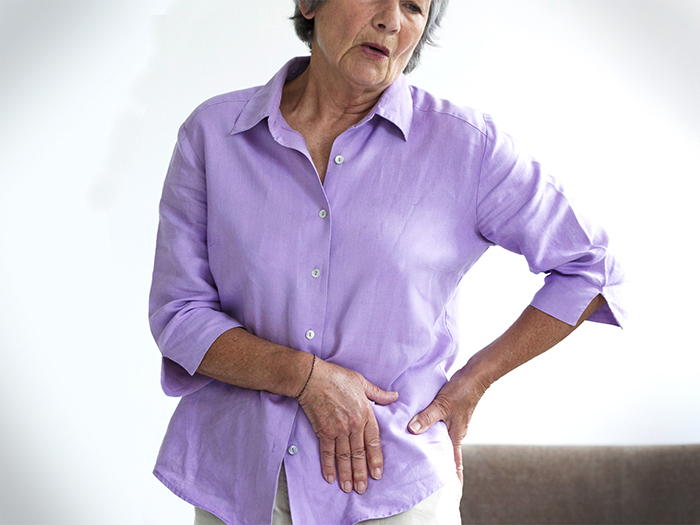
If you have aching hips, taking it easy might seem like the best prescription. Rest is sometimes necessary, but hip pain is often a sign that you should embrace more movement.
Too much sitting is the enemy of stiff or aching hips, says Lisa Woods, a personal trainer and yoga teacher in Eagle, Colorado. The big problem, though, isn’t just the discomfort in the sides of your thighs. It’s the chain of pain that dysfunctional hips can create, including sciatic nerve pain that can start in your lower back and go down the backs of your legs.
The hip joint is designed to withstand a fair amount of wear and tear, but it’s not indestructible. For example, when you walk, a cushion of cartilage helps prevent friction as the hip bone moves in its socket. With age and use, this cartilage can wear down or become damaged, or the hip bone itself can be fractured during a fall. In fact, more than 300,000 adults over 65 are hospitalized for hip fractures each year, according to the Agency for Healthcare Research and Quality.
The good news: You’re not powerless against hip problems. The right exercise routine can go a long way in helping you prevent falls, maintain mobility, and manage pain.
Here are the best exercises for aching hips and the exercises you should limit or avoid. As always, safety is key. The exercises here may be different or more advanced than those you’ll experience in a SilverSneakers class. If you have a chronic condition, balance issues, or injuries, talk to your doctor about how you can exercise safely.
Stay active, have fun, get fit—with SilverSneakers! Classes and events are happening right now at participating gyms, online through SilverSneakers LIVE and at community centers near you. Activate your free online account to get started.
The Best Exercises for Aching Hips
The first step in fighting hip pain is simple: Move your body. If you sit a lot, even small amounts of movement or standing throughout your day can be beneficial, Woods says.
When it comes to your workouts, low-impact aerobic exercises are generally best and least likely to cause issues, says Kelton Vasileff, M.D., an orthopedic surgeon at Ohio State University Wexner Medical Center. “I recommend swimming, walking, elliptical, cycling, and stationary biking for general exercise,” he says. All of these are great ways to move your body without pounding your joints.
Strength training is another key part of the “do” category, Dr. Vasileff says. “It’s a good idea to focus on quad, hamstring, and glute strength,” he says. These muscles surround your hips and provide support, along with your core—which is another area to focus on. “Strengthening your core helps to normalize your walking pattern and stabilize how your pelvis and hips move,” Dr. Vasileff says. That translates to less pain and better hip mobility.
Try incorporating any or all of the following hip exercises into your routine two or three days per week.
1. Band Side Step
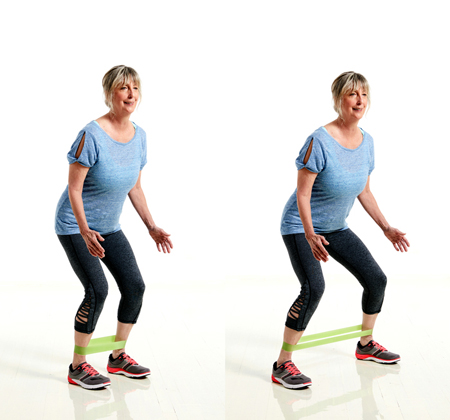
Loop a resistance band above your knees (least resistance), below your knees (medium resistance), or around your ankles (greatest resistance). Bend knees slightly with your feet hip-width apart.
Step to the side until the band provides resistance, then slide your other foot over to re-create your original stance. Repeat this sidestepping movement for 10 to 15 feet in one direction (or as far as you can), and then cover the same distance in the other direction.
Make it easier: Try seated band abductions. With the resistance band tied just below your knees, sit tall with feet about shoulder-width apart. Push your knees outward against the band, pause, and then release. Aim for 10 to 15 reps total.
2. Seated Knee Raise
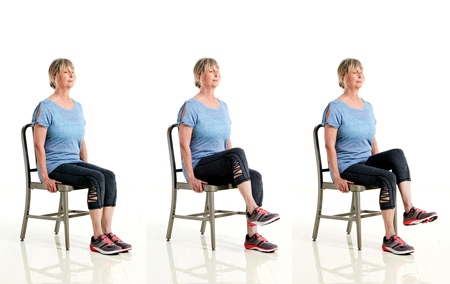
Sit at the front of your chair with knees bent and feet flat, holding on to the sides for balance. You can do this exercise with eyes open. Or for deeper concentration and a balance challenge, try it with your eyes closed.
With your knee bent, lift your right leg about six inches off the floor (or as far as you can). Hold for three counts, and then lower it back to the floor. Repeat with your left leg for one rep. Do 10 reps total.
3. Seated Leg Extension
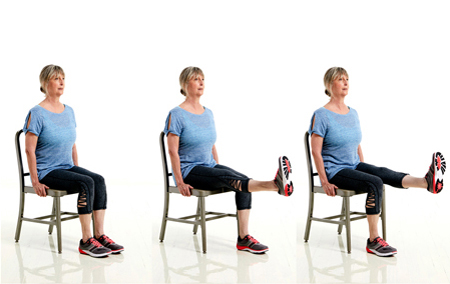
Sit toward the front of your chair with knees bent and feet flat, holding on to the sides for balance.
Keeping your left foot planted and upper body still, straighten your right knee until your leg is parallel with the floor. Hold for two counts, and then lower it back to the floor. Do 10 reps on the right, then repeat on the left.
4. Hip Hinge
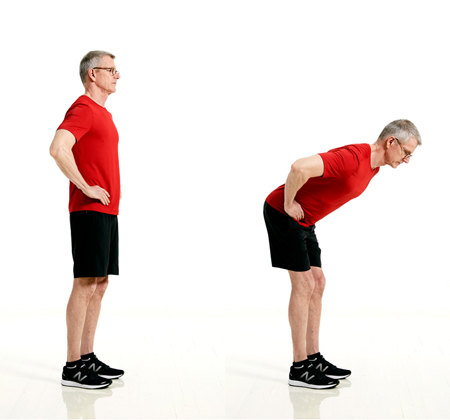
Stand with your feet hip-width apart, knees slightly bent, and hands on hips. Brace your core—imagine you’re about to get punched in the stomach.
Without changing the position of your knees, bend at your hips and lower your torso until it’s almost parallel to the floor (or as far as you can comfortably go without rounding your back). Pause, then lift your torso back to the starting position. Be sure to squeeze your glutes and push your hips forward to lift your torso back to the starting position. This ensures you’re engaging your hip muscles instead of relying on your lower back. Do 10 reps total.
5. Bird Dog Pose
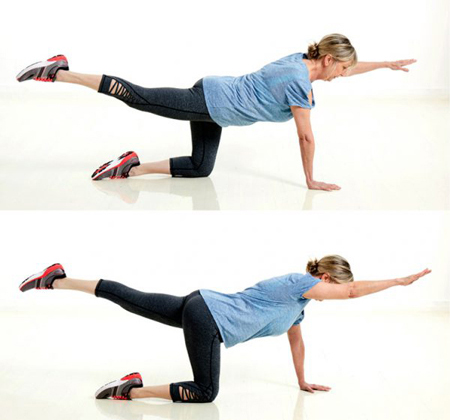
Start on your hands and knees with your palms flat on the mat or floor and shoulder-width apart. Your neck should be in line with your back, and your gaze should be down or slightly forward.
Brace your core, and raise your left arm and right leg until they’re in line with your body. Hold for five to 10 seconds, and then return to the starting position. Repeat on the opposite side (right arm and left leg) to complete one rep. Aim for five to seven reps total.
Make it easier: Keep your hands on the floor, and only extend your leg.
Subscribe to our newsletter
It's quick and easy. You could be one of the 13 million people who are eligible.
Already a member? Click to discover our 15,000+ participating locations.
Follow Us
The Cherry on Top: Yoga
In addition to low-impact cardio and strength exercises like the ones above, yoga can “work wonders for tight hips,” Woods says. The way yoga combines stretching and strengthening the muscles in your hips, legs, and glutes is ideal for helping relieve pain.
One study from Florida Atlantic University found that doing 45 minutes of chair yoga twice per week reduced pain and improved overall quality of life in older adults with osteoarthritis. Chair yoga is practiced sitting in a chair or standing while holding the chair for support, so it’s a great option for beginners or anyone dealing with an injury or balance problems.
Whichever style of yoga you try, seek out proper instruction from a yoga teacher to ensure you’re performing postures correctly. And tell your instructor about any pain or injuries before class so they can suggest modifications. Check out SilverSneakers Yoga or yoga classes, which are offered in-person at participating locations , community centers, or online through SilverSneakers LIVE.
Recommended FREE SilverSneakers On-Demand Class: Chair Yoga for Seniors—Invigorating Total Body Yoga
The Worst Exercises for Aching Hips
In general, if an exercise causes pain in your hips, it’s best to avoid it, Dr. Vasileff says. It’s simple but valuable advice. Common pain-inducing activities are pretty predictable, Dr. Vasileff says. They include:
- Walking on uneven ground or hiking
- High-impact activities such as faster-pace running or jumping
- Lifting heavy weights
Dr. Vasileff also advises against any exercises that require extreme ranges of motion, which he defines as more than 90 degrees of bend at the hip or knee. Deep squats are an example of this type of movement.
Woods includes lunges and stepups in the “don’t” category. “It can be difficult for those with troubled hips to maintain proper form in these poses, which places additional strain on the hips,” she says.
Activate Your FREE SilverSneakers Online Account
Get hundreds of free SilverSneakers On-Demand videos and stay in touch with us by creating your free online account. You don’t have to be a SilverSneakers member to get on-demand workout videos, health and fitness tips from SilverSneakers, and more.
SilverSneakers members can go to thousands of nationwide gyms and fitness locations, plus take SilverSneakers LIVE online classes led by specially trained instructors and designed for all fitness levels and abilities – at no additional cost. If you have a Medicare Advantage plan, it may include SilverSneakers. Check your eligibility here.
Already a member? Get your SilverSneakers member ID, search for locations near you, and all the health and wellness resources you need by logging in to your online member account here.





